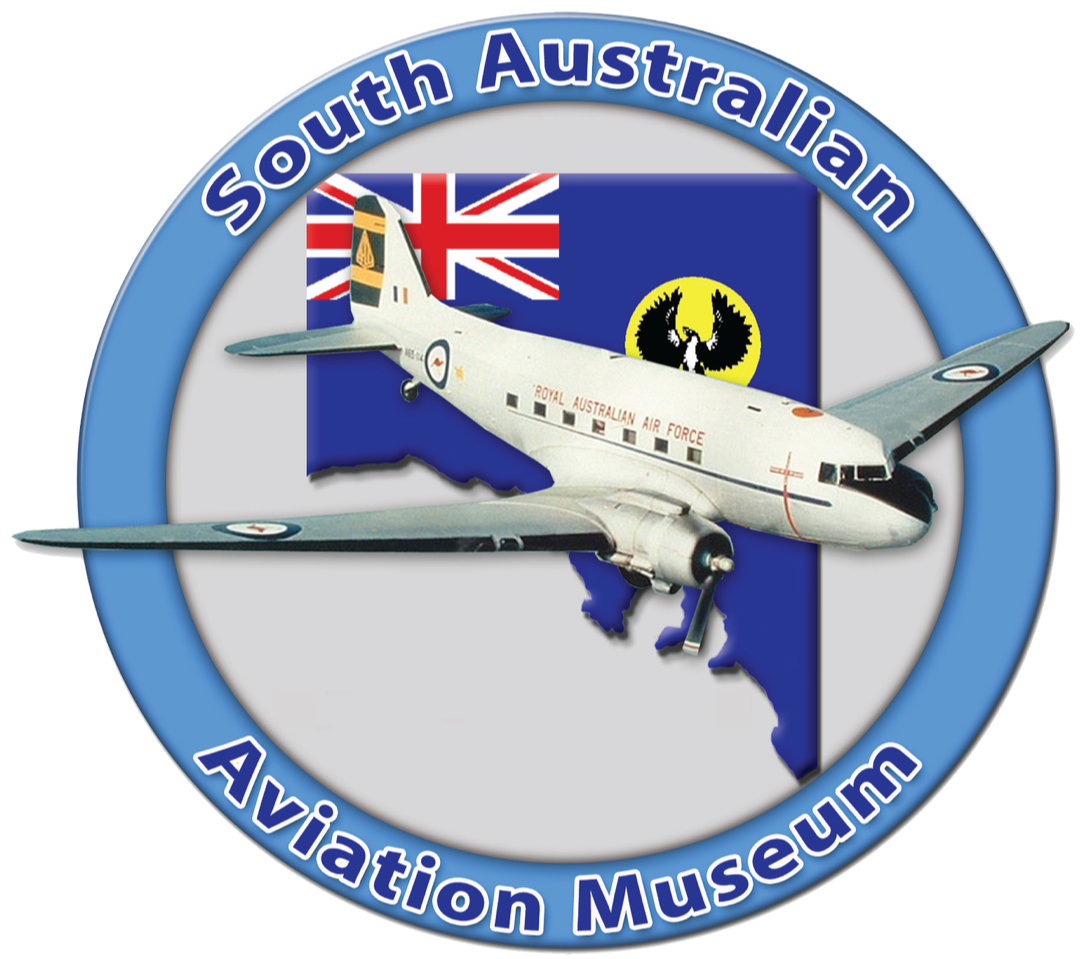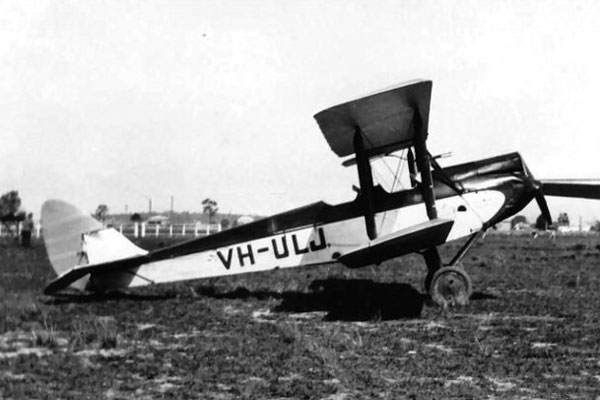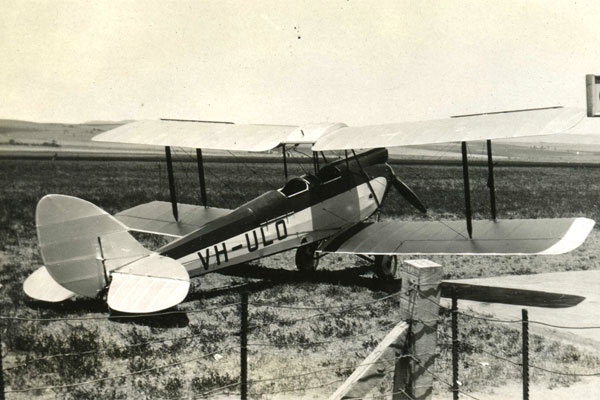SAAM acquired two de Havilland Gipsy Moths (VH-ULJ and VH-ULO) in 1991. From 1965 to 1991, they were in the Birdwood Mill Museum (now known at the National Motor Museum). They were at the South Australian Museum of Applied Science, North Terrace, Adelaide, from November 1942 until 1961. Both of the Moths were in poor condition when they arrived at SAAM. VH-ULJ has undergone an extensive restoration and is now on display in Hangar 1. VH-ULO is incomplete and is currently in storage awaiting restoration. In the photo of VH-ULO (above) you will notice the vertical stripes on the tail, which was a mark of the Aero Club.
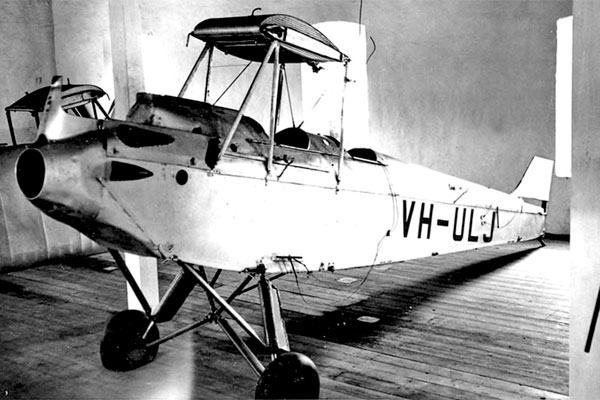
VH-ULJ at Birdwood Mill Museum

VH-ULO at SAAM
de Havilland Gipsy Moth VH-ULJ
de Havilland Gipsy Moth VH-ULJ is a DH.60G (wooden fuselage), first registerd to Qantas 20 Feb 1929. On 3 Aug 1929, it was transferred to W.R. Evans, Berridale, NSW and operated by the Northern Rivers Flying School at Ballina NSW and then to Archerfiels in June 1930. In 1932, its registration lapsed and it was restored. On 22 March 1933 it was transferred to Mrs. Edna Brett, Yeronga, Brisbane and then it was transferred to Holden's Air Transport Service, Salamaua, New Guinea on 3 Nov 1933.
VH-ULJ was used in the development of the Bulolo goldfields (a very rich goldmine located in the middle of the rugged Owen Stanley Range). It was based initially at Salamaua on the New Guinea coast and used to transport miners and their supplies over the New Guinea mountains. A flight of less than an hour replaced what was once a five-day walk through very steep mountains. On8 Feb 1936, it was badly damaged when it hit boulders while landing at Surprise Creek, New Guinea. It was repaired and in Dec 1936 Holden's Air Transport Service was taken over by Guinea Airways. VH-ULJ was registered to Guinea Airways, Wau, New Guinea on 16 Nov 1937. It was based at Lae where it operated until September 1941 withdrawn from use after cracks were found in the rear fuselage longerons. It was reported as 'patched up' and flown by M. Blackman from Wau, New Guinea to Townsville via. Daru and Horn Island in Feb 1942 to escape the Japanese invasion of New Guinea and subsequently to Parafield, South Australia.
The registration for VH-ULJ was cancelled on 26 Nov 1942 and it was sold to the Education Department of South Australia to be used as an 'Instructional Airframe'. Its total flying time was 4,300 hours. It was put on display in the SA Museum of Applied Science, North Terrace, Adelaide, from November 1942 until 1961 when it went into storage. In 1965 it was transported to the Birdwood Mill Museum. VH-ULJ was sold in 1980 to J. Delaney, Nailsworth, South Australia, who started the rebuild. VH-ULJ came to SAAM on 1 June 1991, and after restoration was put on display.
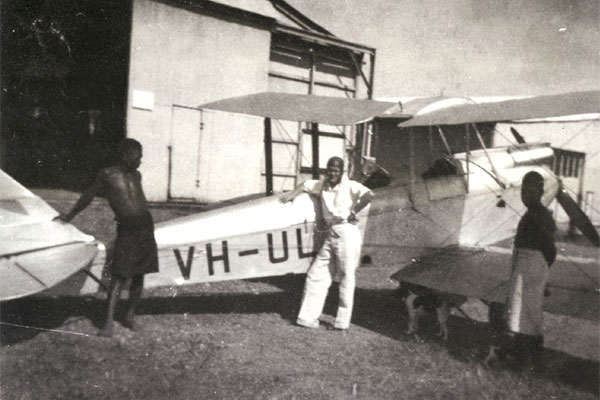
VH-ULJ parked at Lau (New Guinea) in the 1920's
Pilot is believed to be Charlie Gray .
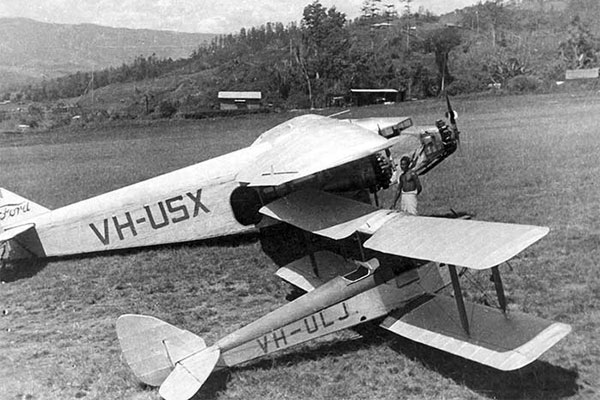
VH-ULJ at Wau (New Guinea) in the 1920's
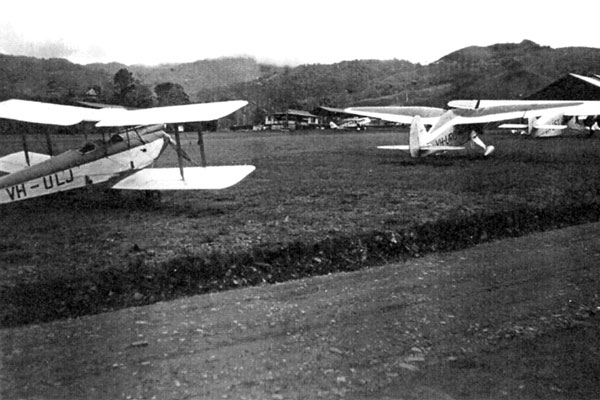
VH-ULJ parked at Wau (New Guinea)
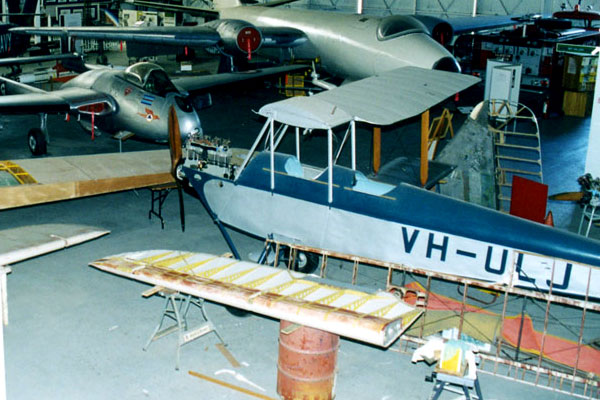
VH-ULJ in SAAM's Hangar
History of Type
The prototype De Havilland DH-60 G-EBKT first flew on 22 February 1925 at Stag Lane, UK, piloted by Geoffrey de Havilland (later Sir Geoffrey). Its simple lines and outstanding performance on low power set an instantly popular fashion in light aircraft configuration, which lasted for several decades.
This two-seat basic trainer was an instant success around the world with the first of the type being imported into Australia in 1926. They were initially used by Aero Clubs and the RAAF. The latter used them until replaced by the DH-82 Tiger Moth. The DH-60 type was also used by charter operators, for news reporting, aero medical services, mineral exploration, by private owners, and for aerial photography (most notably by Adelaide photographer D Darian Smith).
de Havilland Gipsy Moth VH-UL0
VH-ULO is a de Havilland DH.60M Gypsy Moth (metal fuselage), first registered on 13 Dec 1929 to Civil Aviation Branch, Department of Defence and loaned to the Australian Aero Club. It was flown to Parafield by G. K. Rice-Oxley on 16 Dec 1929 to be used by the South Australian Branch operating at Parafield, South Australia.
VH-ULO was flown by many notable South Australian pilots between 1929 and 1937 including Jimmy Melrose, Brownie Lunn, Helen Cato and Roy Gropler. On 12 Nov 1929, the name was changed to the Aero Club of South Australia and on 4 August 1936 it became 'The Royal Aero Club of South Australia' (The Royal Aero Club of S.A. ceased flying operations in December 1981).
A Medical Emergency & Crash
On 26 April 1930, VH-ULO was en-route to Alice Springs with pilot Jack Jukes and passenger Dr. Jungfer when they crashed near Orroroo. The pair were rushing to Alice Springs to attend an urgent medical case where the patient was suffering from blood poisoning. Dr. Jungfer was taking a supply of serum with him. They left Parafield at 5.30am and were hoping to reach Alice Springs before nightfall (816 miles or 1312km). About 23 miles north of Orroroo they ran into a thick fog with about 15 feet visibility. They crashed into a 400 ft range near Minburra Station. Dr. Jungfer was pinned in the cabin. The wreckage was pressing against his forehead and the back of his head. Mr. Jukes took around 30mins to free Dr. Jungfer. They found a track and walked about 3 and a half miles to the station where Mr. Rasheed assisted the pair. It was later reported that both the pilot and passenger had sustained minor injuries. Another aeroplane was obtained at Hawker and the serum was sent on to Alice Springs by way of Marree, Oodnadatta and William Creek. Later in the same year, on 26 Dec 1930 VH-ULO was badly damaged in a forced landing at Yoko Station, Yankalilla, South Australia. A rebuild was completed on 10 Oct 1931
A Series of Unfortunate Events
On 26 Dec 1930, Dr. H.C. Nott made a forced landing near Yankalilla in VH-ULO when he lost all fuel through a leak in the flexible petrol feed tube between the filter and the carburettor. No damage was detailed, but it must have been significant as the club approached the Civil Aviation Branch for assistance to repir it. VH-ULO was out of service for nine months.
On 22 Jan 1930, Helen Cato (flying solo) made a heavy landing in VH-ULO but the damage was minor, with some broken bracing wires and a fracture of the plywood between the cockpits. The repairs only took a few days. VH-ULO was damaged again in April 1930, its propellor was damaged prior to leaving for Melbourne to take part in the Victorian Branch Pageant.
VH-ULO suffered a hard landing on 24 Feb 1935, another on 7 June and yet another on 26 Dec. at Callington.
The Brownie Lunn Connection
VH-ULO underwent a major reconditioning and was wired for night flying in Jan 1933.
On 3rd August 1934, it was reported in the Adelaide Advertiser that the Aero Club was training student pilots in night flying in VH-ULO. Those under instruction included Miss. M. F. (Brownie) Lunn. Ms. Lunn has been recognised as the first Australian woman pilot to go night flying.
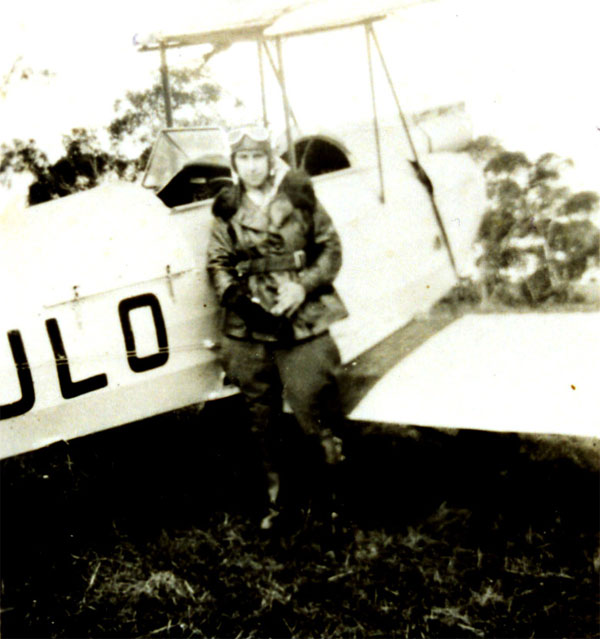
Brownie Lunn in front of VH-ULO
The Roy Gropler Connection
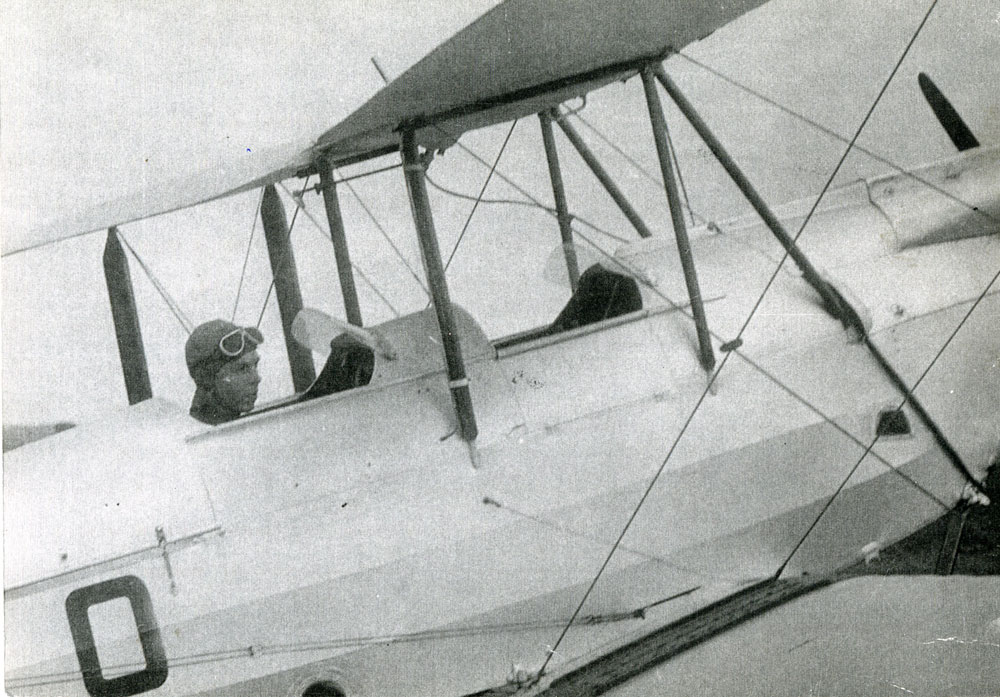
Roy Gropler in VH-ULO c1934.
Around 3.15pm on Sunday 16 December 1934, Roy Gropler was flying VH-ULO at about 2,000 ft over Toorak Gardens when an oil pipe burst. Mr. Gropler put the machine into an easy glide and made a forced landing at Victoria Park racecourse. At the time Mr. Gropler was one of the youngest aviators in South Australia and was employed by the Aero Club as an assistant ground engineer. The plane was repired and flow back to Parafield the same day. Three months later, Gropler was suspended from flying for a month for performing aerobatics over Rose Park.
The End for VH-ULO
Richard Dutton (from Anlaby Station) was flying VH-ULO when it crashed at Anlaby Station, Kapunda, S.A. on 21 Sep 1937. It was reported that he had sufferred abrasions to the face and legs, two teeth knocked out and was in shock. The aircraft was reported to be in poor shpe, with the propellor broken and the undercarriage torn away. The Dutton family agreed to pay a settelment to the Aero Club. VH-ULO was never repaired. The engine was later used in VH-UTN (which was a plane flown by Nancy Bird Walton). The registration was cancelled on 18 Dec 1939 and it was sold to the S.A Museum of Applied Science, Adelaide. In 1965, it went to the Birdwood Mill Museum (with VH-ULJ). Both VH-ULJ and VH-ULO were deliverd to SAAM on 1 June 1991.
